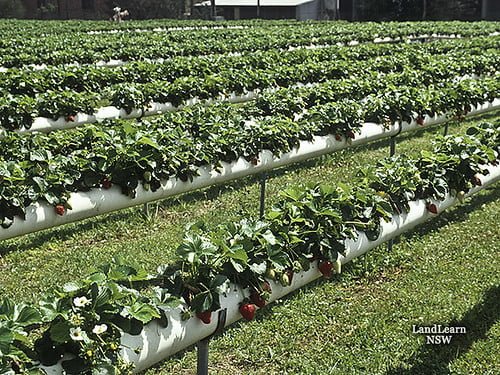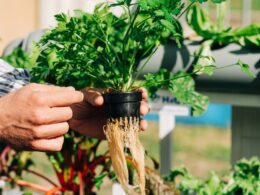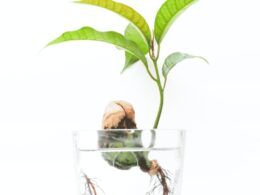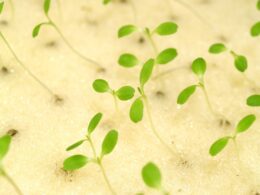Are you struggling with algae growth in your hydroponic system? Algae can not only be unsightly, but it can also harm your plants by competing for nutrients and blocking light. Luckily, there are several ways to control and eliminate algae in hydroponics.
In this article, we will discuss the causes of algae growth in hydroponics and provide practical solutions for preventing and treating algae. Whether you are a seasoned hydroponic gardener or just starting out, understanding how to effectively control algae will ensure healthy plant growth and a successful harvest.
So, let’s dive in and explore what kills algae in hydroponics.
Understand the Causes of Algae Growth in Hydroponics
Understanding the reasons why algae thrives in a hydroponic system is crucial in maintaining a healthy and balanced growing environment. Algae growth is commonly caused by excess light exposure, nutrients, and stagnant water. When these factors are not controlled, algae can quickly take over and harm your plants.
To prevent algae growth, it’s important to limit light exposure by shading your hydroponic system or using lightproof covers. Additionally, make sure to use hydroponic solutions with the correct nutrient balance and avoid overfeeding your plants. Finally, ensure proper water flow and circulation to prevent stagnant water, which can become a breeding ground for algae.
By taking preventative measures, you can avoid the negative effects of algae on your hydroponic system and ensure that your plants thrive. Keep in mind that the key to a successful hydroponic system is maintaining a balanced environment that promotes healthy growth and eliminates the risk of harmful algae growth.
Use Physical Barriers to Prevent Algae Growth
To prevent algae growth in your hydroponic system, try using physical barriers like covering the nutrient solution with a lid or using light-blocking materials. This will help reduce the amount of light that reaches the nutrient solution, which is essential for algae growth.
By taking these proactive steps, you can ensure that your hydroponic plants receive the nutrients they need to grow without competing with algae for resources.
Covering the nutrient solution
Covering your nutrient solution is a great way to prevent algae growth in your hydroponic system. This can have a big impact on the health of your plants, as algae can quickly take over your nutrient solution and rob your plants of the nutrients they need to grow.
By covering your solution, you can keep it clean and healthy for your plants to thrive in. There are many benefits of covering your nutrient solution. First, it can help prevent the growth of algae, which can be a major problem in hydroponic systems.
Second, covering your solution can help keep out debris and other contaminants that can harm your plants. There are many different types of covers you can use, from simple plastic sheeting to more advanced covers that are designed specifically for hydroponic systems. Whatever type of cover you choose, make sure it fits securely over your nutrient solution to prevent any air or light from getting in.
Using light-blocking materials
You can enhance the growth of your plants by using light-blocking materials in your hydroponic system. Light-blocking films are a popular choice for this purpose as they’re easy to install and provide maximum coverage. These films are made of a special material that blocks out all wavelengths of light, preventing any algae growth in your nutrient solution.
If you’re on a budget, you can also opt for DIY light barriers made of cardboard or black plastic. These materials are easily available and can be cut to size to fit your hydroponic system.
Here are some benefits of using light-blocking materials in your hydroponic system:
-
Prevents algae growth: Light-blocking materials prevent sunlight from entering the nutrient solution, which in turn prevents the growth of algae.
-
Increases nutrient uptake: With no competition from algae, your plants will be able to absorb nutrients more efficiently.
-
Lowers maintenance: Without algae, you won’t have to clean your hydroponic system as often, saving you time and effort.
-
Improves plant growth: By providing a clean and controlled environment, your plants will be able to grow healthier and faster.
Can the Methods Used to Kill Algae in Hydroponics be Applied to Naturally Reduce Algae?
Can the methods used to kill algae in hydroponics be applied to naturally reduce algae? Interestingly, hydroponic systems utilize various techniques to eliminate algae, such as UV sterilization and biological control. However, when it comes to naturally reducing algae in other settings, alternative methods like optimal filtration, introducing algae-eating fish, and promoting healthy competition among aquatic plants can be effective strategies. Ultimately, nature can take its course in naturally reducing algae.
Implement Good Maintenance Practices
Maintaining your hydroponic system regularly will keep your plants healthy and thriving, preventing any unwanted growth from interfering with their growth. Regular cleaning is an important aspect of good maintenance practices.
Clean out any debris or dead plant matter from your system, and check for any signs of algae growth. If you see any algae, be sure to remove it immediately before it has a chance to spread.
In addition to regular cleaning, there are other preventative measures you can take to keep algae at bay. Make sure your system is properly ventilated and that the water temperature is not too high. Algae thrives in warm, stagnant water, so keeping the water moving and at a cooler temperature will help prevent its growth.
You can also add beneficial bacteria to your system, which will outcompete the algae for nutrients and help keep it from growing. By implementing good maintenance practices and taking preventative measures, you can keep algae from taking over your hydroponic system and harming your plants.
Remember to clean your system regularly, keep the water moving and at a cooler temperature, and add beneficial bacteria to your system. With a little bit of effort and attention, your hydroponic system can thrive and produce healthy, vibrant plants.
Use Chemical Treatments to Control Algae Growth
Using chemical treatments is an effective way to control the growth of unwanted algae in your hydroponic system, but it’s important to remember to use them responsibly and only as a last resort.
There are chemical alternatives available that are less harmful to the environment and your plants, so it’s important to research and choose the best option for your specific situation.
When using chemical treatments, always follow the instructions carefully to avoid overuse and potential risks.
It’s also important to monitor the pH and nutrient levels in your system, as some chemicals may affect them.
Remember that chemical treatments should be a last resort, and implementing good maintenance practices such as regular cleaning and proper nutrient management can prevent algae growth from becoming a problem in the first place.
While chemical treatments can be effective, it’s important to weigh the potential risks before using them.
Some chemicals can be harmful to aquatic life and the environment, and may also affect the taste and quality of your plants.
Always research and choose a chemical treatment that is safe for your plants, and use it only when necessary and in moderation.
With proper research and responsible use, chemical treatments can be a useful tool in controlling algae growth in your hydroponic system.
Explore Natural Methods for Algae Control
Let’s take a look at some eco-friendly solutions to keep your hydroponic system clean and clear of unwanted green invaders. One natural remedy for algae control is using barley straw. Simply add some barley straw to your hydroponic system, and the straw will release compounds that inhibit algae growth. Another DIY solution is to use hydrogen peroxide. Mix one tablespoon of hydrogen peroxide with one gallon of water, and add the mixture to your hydroponic system. The hydrogen peroxide will oxidize the algae and keep it from growing.
Here is a table to show you the benefits of using natural remedies for algae control:
| Benefits of Natural Remedies | |
|---|---|
| Safe for plants and animals | ✅ |
| Environmentally friendly | ✅ |
| Reduce the need for chemical treatments | ✅ |
| Cost-effective | ✅ |
As you can see, using natural remedies for algae control has many benefits. Not only are they safe for your plants and animals, but they are also environmentally friendly and cost-effective. By reducing the need for chemical treatments, you can create a healthier and safer hydroponic system.
Incorporating natural remedies and DIY solutions into your hydroponic system can be a simple and effective way to control algae growth. With the benefits of using natural remedies, it’s worth giving it a try. Experiment with different solutions and find what works best for your system. By using natural methods, you’ll have a cleaner and healthier hydroponic system for your plants to thrive in.
Frequently Asked Questions
Can algae growth in hydroponics affect the taste of the plants?
If you’re growing plants in a hydroponic system, you should be aware of the potential impact of algae growth on the quality of your plants. Algae can negatively affect the taste and overall health of your plants, so it’s important to take steps to control it.
There are several methods you can use to control algae growth, such as adjusting the pH level of your water, using UV light, or adding an algaecide. However, it’s important to compare the different methods and choose the one that works best for your specific situation.
By taking proactive steps to control algae growth, you can help ensure that your hydroponic plants are healthy and flavorful.
How often should physical barriers be checked and cleaned to prevent algae growth?
To prevent algae growth in your hydroponic system, it’s important to regularly check and clean your physical barriers. The frequency of maintenance depends on the effectiveness of your barriers and the amount of light and nutrients in your system.
It’s recommended to check your barriers at least once a week and clean them as needed. This will help prevent algae from clogging your system and affecting the growth of your plants.
By taking these simple maintenance steps, you’ll ensure a safe and healthy environment for your plants to thrive in.
Are there any negative side effects of using chemical treatments to control algae growth?
If you’re looking to control algae growth in your hydroponic system, you may be tempted to turn to chemical treatments. However, it’s important to consider the potential harm that these treatments can cause to both your plants and the environment.
Some chemicals can be toxic to your plants, and can even accumulate in the water over time, leading to long-term damage. Instead, it’s worth exploring sustainable alternatives, such as physical barriers or biological controls, which can help to prevent algae growth without introducing harmful chemicals into your system.
By taking a more natural approach to algae control, you can ensure that your plants stay healthy and your system remains sustainable for years to come.
What are some natural methods for algae control that don’t involve chemicals?
One natural method to control algae in hydroponics is through the use of composting tea. This is a mixture of compost and water that is brewed for a certain amount of time to create a nutrient-rich liquid that can be added to the hydroponic system.
The tea helps to promote the growth of beneficial bacteria that can outcompete the algae for nutrients. Another natural method is to introduce beneficial bacteria directly into the system. These bacteria can help to break down organic matter and prevent the buildup of nutrients that algae need to thrive.
By using these natural methods, you can effectively control algae growth in your hydroponic system without the use of harmful chemicals.
Can algae growth in hydroponics be harmful to human health?
Algae growth in hydroponics can pose health risks if not properly controlled. Algae produces toxins that can be harmful to humans if ingested or inhaled. These toxins can cause skin irritation, respiratory problems, and even liver damage.
It’s important to monitor and control algae growth in hydroponics systems to prevent the accumulation of these harmful toxins. Regular cleaning and maintenance of the system, as well as the use of natural algae control methods, can help mitigate these health risks.
Conclusion
Congratulations! You now know the different methods on how to kill algae in hydroponics. By understanding the causes of algae growth, you can prevent it from happening in the first place.
Physical barriers like light-blocking films and good maintenance practices like proper cleaning and sterilization can also help control algae growth.
If physical barriers and maintenance practices aren’t enough, you can use chemical treatments like hydrogen peroxide or copper sulfate to control algae growth. However, always follow the instructions carefully to avoid harming your plants.
Lastly, exploring natural methods like introducing beneficial microorganisms or using natural algae inhibitors can also be effective in controlling algae growth.
Remember, preventing and controlling algae growth is essential in maintaining a healthy hydroponic system. Keep an eye on your plants and take action immediately to avoid any negative effects on their growth. With these tips, you can now maintain a clean and thriving hydroponic garden.









